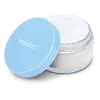What's inside
What's inside
 Key Ingredients
Key Ingredients

 Benefits
Benefits

 Concerns
Concerns

 Ingredients Side-by-side
Ingredients Side-by-side

Silica
AbrasiveCorn Starch Modified
AbsorbentDimethicone/Vinyl Dimethicone Crosspolymer
Skin ConditioningCaprylic/Capric Triglyceride
MaskingSynthetic Fluorphlogopite
CI 77891
Cosmetic ColorantMethicone
EmollientParfum
MaskingEthylhexylglycerin
Skin ConditioningDehydroacetic Acid
PreservativeTin Oxide
AbrasiveWater
Skin ConditioningCI 77491
Cosmetic ColorantEthylene/Acrylic Acid Copolymer
Emulsion StabilisingMineral Salts
Skin ConditioningMica
Cosmetic ColorantButylene Glycol
HumectantMentha Arvensis Leaf Extract
MaskingCamellia Sinensis Leaf Extract
AntimicrobialTocopherol
Antioxidant1,2-Hexanediol
Skin ConditioningPhenoxyethanol
PreservativeSilica, Corn Starch Modified, Dimethicone/Vinyl Dimethicone Crosspolymer, Caprylic/Capric Triglyceride, Synthetic Fluorphlogopite, CI 77891, Methicone, Parfum, Ethylhexylglycerin, Dehydroacetic Acid, Tin Oxide, Water, CI 77491, Ethylene/Acrylic Acid Copolymer, Mineral Salts, Mica, Butylene Glycol, Mentha Arvensis Leaf Extract, Camellia Sinensis Leaf Extract, Tocopherol, 1,2-Hexanediol, Phenoxyethanol
Talc
AbrasiveZea Mays Starch
AbsorbentZinc Oxide
Cosmetic ColorantZinc Stearate
Cosmetic ColorantTitanium Dioxide
Cosmetic ColorantPhenoxyethanol
PreservativeDimethicone
EmollientEthylhexylglycerin
Skin ConditioningAluminum Hydroxide
EmollientHydrogen Dimethicone
Parfum
MaskingTocopherol
AntioxidantGlycyrrhiza Glabra Root Extract
BleachingCI 77492
Cosmetic ColorantCI 77491
Cosmetic ColorantCI 77499
Cosmetic Colorant
 Reviews
Reviews

Ingredients Explained
These ingredients are found in both products.
Ingredients higher up in an ingredient list are typically present in a larger amount.
Ci 77491 is also hydrated iron III oxide. It's sole purpose is to give a red/pink hue to products.
Iron III oxides are classified as inorganic chemicals for coloring.
Synthetically created Ci 77491 is considered safer than those naturally found. This is because the synthetically created version may contain less impurities. Iron oxides are generally non-toxic and non-allergenic.
Learn more about CI 77491Ethylhexylglycerin (we can't pronounce this either) is commonly used as a preservative and skin softener. It is derived from glyceryl.
You might see Ethylhexylglycerin often paired with other preservatives such as phenoxyethanol. Ethylhexylglycerin has been found to increase the effectiveness of these other preservatives.
Parfum is a catch-all term for an ingredient or more that is used to give a scent to products.
Also called "fragrance", this ingredient can be a blend of hundreds of chemicals or plant oils. This means every product with "fragrance" or "parfum" in the ingredients list is a different mixture.
For instance, Habanolide is a proprietary trade name for a specific aroma chemical. When used as a fragrance ingredient in cosmetics, most aroma chemicals fall under the broad labeling category of “FRAGRANCE” or “PARFUM” according to EU and US regulations.
The term 'parfum' or 'fragrance' is not regulated in many countries. In many cases, it is up to the brand to define this term.
For instance, many brands choose to label themselves as "fragrance-free" because they are not using synthetic fragrances. However, their products may still contain ingredients such as essential oils that are considered a fragrance by INCI standards.
One example is Calendula flower extract. Calendula is an essential oil that still imparts a scent or 'fragrance'.
Depending on the blend, the ingredients in the mixture can cause allergies and sensitivities on the skin. Some ingredients that are known EU allergens include linalool and citronellol.
Parfum can also be used to mask or cover an unpleasant scent.
The bottom line is: not all fragrances/parfum/ingredients are created equally. If you are worried about fragrances, we recommend taking a closer look at an ingredient. And of course, we always recommend speaking with a professional.
Learn more about ParfumPhenoxyethanol is a preservative that has germicide, antimicrobial, and aromatic properties. Studies show that phenoxyethanol can prevent microbial growth. By itself, it has a scent that is similar to that of a rose.
It's often used in formulations along with Caprylyl Glycol to preserve the shelf life of products.
Tocopherol (also known as Vitamin E) is a common antioxidant used to help protect the skin from free-radicals and strengthen the skin barrier. It's also fat soluble - this means our skin is great at absorbing it.
Vitamin E also helps keep your natural skin lipids healthy. Your lipid skin barrier naturally consists of lipids, ceramides, and fatty acids. Vitamin E offers extra protection for your skin’s lipid barrier, keeping your skin healthy and nourished.
Another benefit is a bit of UV protection. Vitamin E helps reduce the damage caused by UVB rays. (It should not replace your sunscreen). Combining it with Vitamin C can decrease sunburned cells and hyperpigmentation after UV exposure.
You might have noticed Vitamin E + C often paired together. This is because it is great at stabilizing Vitamin C. Using the two together helps increase the effectiveness of both ingredients.
There are often claims that Vitamin E can reduce/prevent scarring, but these claims haven't been confirmed by scientific research.
Learn more about Tocopherol